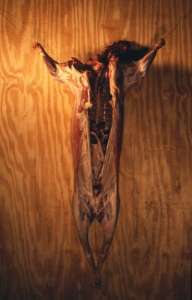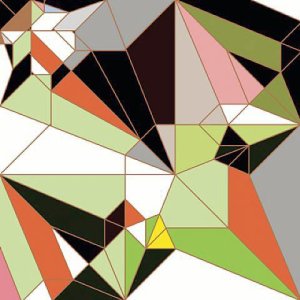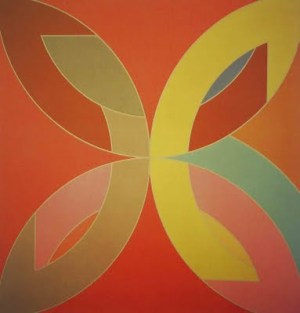Andre Butzer – Ahnenbild 2411
From the banal to the sublime…
Volker Hueller – Self Portrait.
‘Gesamkunstwerk’ – ‘a total work of art’ – uses all or many art forms. (Dictionary definition.)
Intrigued by the title which has many facets and does not easily translate into English I made my first trip to the new Saatchi Gallery. A little late in the day but then I only visited the original one in North London a couple of times and missed out on the South Bank farrago. Intrigued however was not how I felt by the time I had left and I certainly had not seen an all encompassing show of the arts as promised by the title. Indeed I felt more like I had entered a time-warp and stumbled into the New Spirit in Painting show at the Royal Academy circa 1981 but without the same excitement or technique on display. The most impressive feature was the building itself which is a Wagnerian symphony of contemporary gallery chic and cannot be faulted. Indeed a more impressive set of floorboards I have never seen. If the building is intended to impress it succeeds but at what cost? Most of the work seemed quietly subdued by its illustrious surroundings and indeed a good deal of it sank altogether. Formerly famous for setting the ship of Britart afloat how does this show succeed in opening our eyes to New German Art of the 2010′s? Well, frankly, not very well.
There are good individual artists in this show but after finding ones way around all the floors and finally being overwhelmed by the frankly awful huge works at the top I felt I had no more idea about contemporary German Art than I had when I arrived. The picture-book ‘catalogue’ does little to enlighten and whilst I not keen on over explication a little more info would have helped greatly. My impression was that bar a rough correlation of ages there was little to tie the artworks together and this had been manufactured quickly and with little curatorial thought. The one common factor was an almost complete lack of digital works. This was about big, bigger and huge…almost all the works were over six foot and in some cases were collossal. In that there were echoes of the far better German artists of the R.A. show e.g. Penck, Middendorf, Baselitz, etc. but there comparisons ended. I did not see one painter on a large scale that really showed exceptional technique or content. It was almost as if a T.V. reality show had asked a bunch of fairly average artists to create a pastiche of German Art of the last thirty years in a week.
Some works were truly awful e.g. the reclining plastic coloured figures and the afore-mentioned ‘print’ across a hundred canvasses. Others were good but lost in the hang apart from the Tobias Brothers and the small shellac and watercolour works of Volker Hueller both of which I was impressed by. I will not add insult to injury by naming the worst of a fairly mediocre bunch but winners of irritating and downright stupid awards go to Andre Butzer ( New York Graffitti school overdosed on Penck with a horrible use of colour) and Isa Genzken’s tedious assemblages like a car boot sale organized by Rauschenburg if he’d been a pantomime Dame…tinsel and spray paint darlinks is so camp …yuk. It is easier to actually spot the reference in most works. Maz Frisinger and Alexander Bircken wouldn’t have a practice without Duchamp’s large glass basically and Ida Ekbald looked like a foundation art project to use concrete that had gone horribly wrong. It seems that such is the plethora of art students coming out of the academies that even basic aesthetics have been jettisoned. Maybe she networks really well..maybe you have to living in Norway..so how come she in a German show..ah she lives in Berlin well that’s alright then…shame they didn’t chuck Tacita Dean in too at least we could have seen something interesting. By the way Tobias Brothers were born in Romania so is this really New Euro Art? Again the contextual strings were missing…if a Norwegian then is this really German Art now or just a motley collection hastily cobbled together..methinks the latter. This is reinforced by the seemingly haphazard way works melt into each other. If Saatchi can afford to build such a place why does he not employ some decent designers to fashion some continuity and catalogue support. If ‘democratising’ the artworld means flabby shows with little thought I may not be so ‘democratic’ in future. Free to enter you do get what you pay for. It seems Saatchi is keener on being seen as super-patron than actually doing the right thing by the art he assembles. But then he is bigger (as his building) than any poor artist caught in their combined wash.
The show is worth going to for the well hung Tobias Brothers room and for the Hueller small works both of which show grace and aesthetic consideration rather than the Pantomime Showiness of most of it. I came away with the impression that New German Art had fallen into a rut of pastiche of former glories and far from benefitting from new immigration the ‘Eurozone’ dizziness of it all had actually devalued some of the participants. If a single currency has devalued the economies of Western Europe then this show displays that Saatchi’s global reach and international obsessions are similarly dangerous to ‘national’ ideas of art. Post internet, post Berlin Wall what we see is a weak and diluted parade of imitators and hangers-on to concepts and working practices which were old hat in 1960. If you want to see post-war German art at its best go google ‘Mülheimer Freiheit‘. This is just a pantomime of the new wilds and honestly it as tame a collection of physical art as I ever come across..one almost yawned on exit. Maybe Saatchi can blame his ‘art-teams’ for nothing on this scale is supervised that closely…..commitee and buyers do the rounds hoovering up those who fit the bill.
Want to be in the next National Saatchi show…tick these boxes….International (i.e. not English) …large and technically inept and finally be devoid of real artistic merit…then you may stand a chance.
I would like to see a ‘opt-out’ clause for British native art from this circus before we all become clowns dancing to the same ringmaster.
CODA: Is Serota’s Tate any different?..same egos just different paymasters…

















